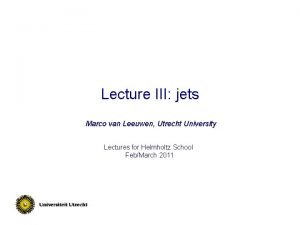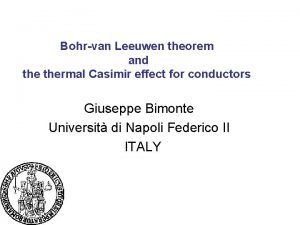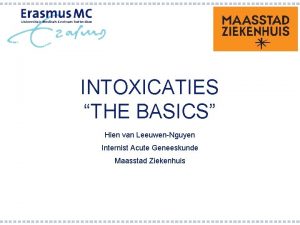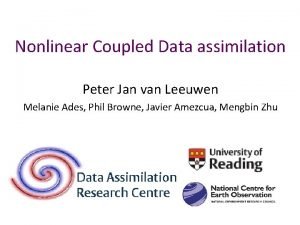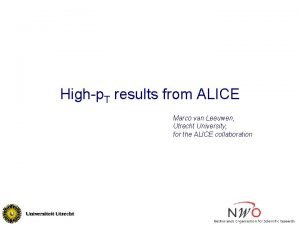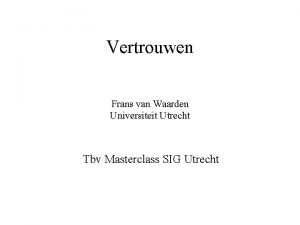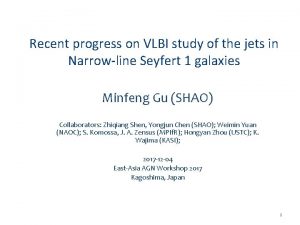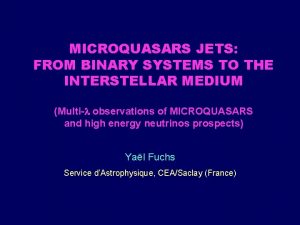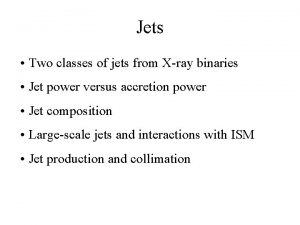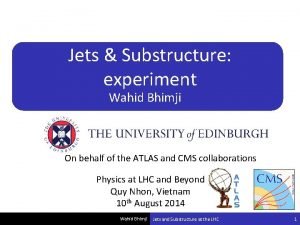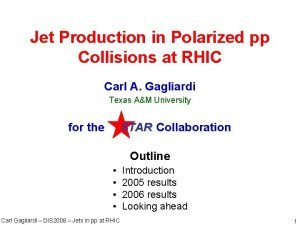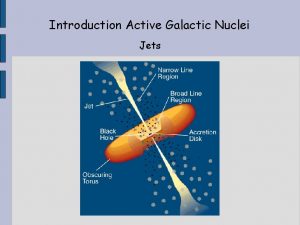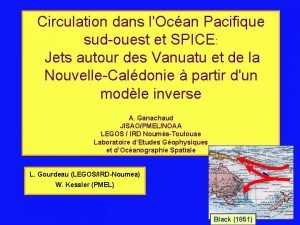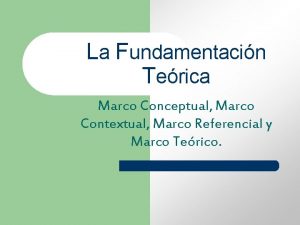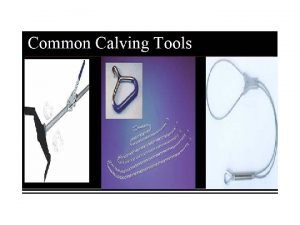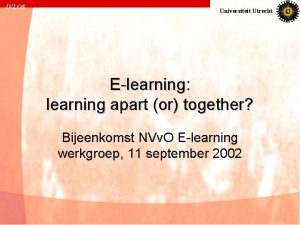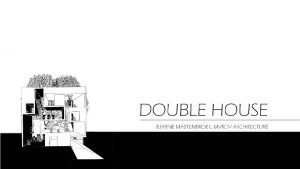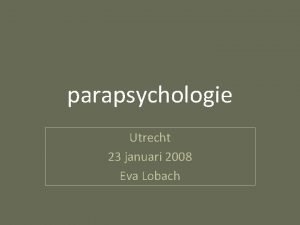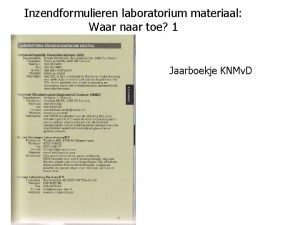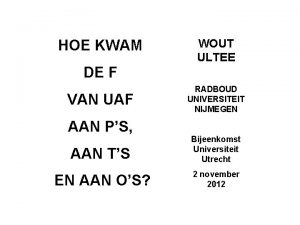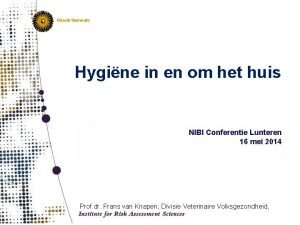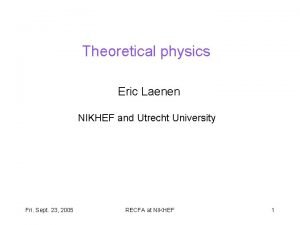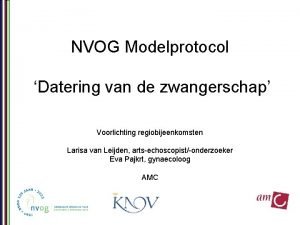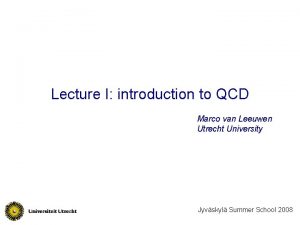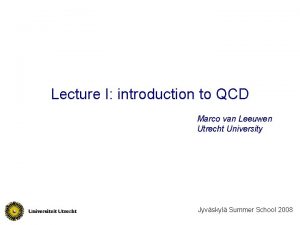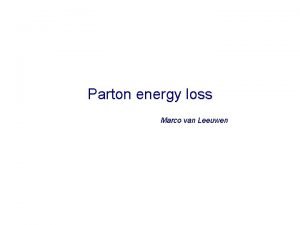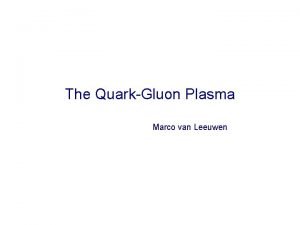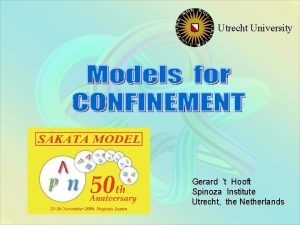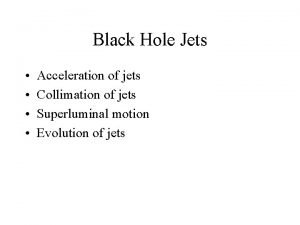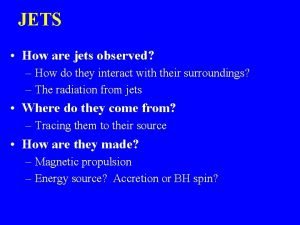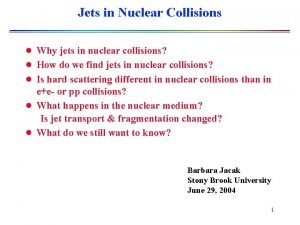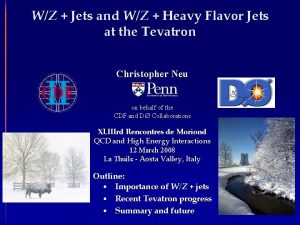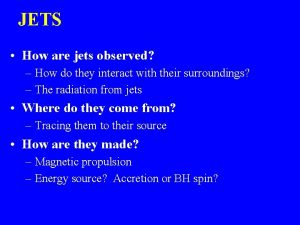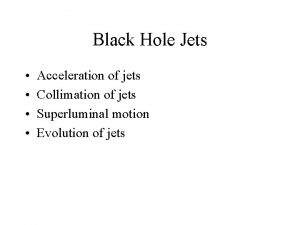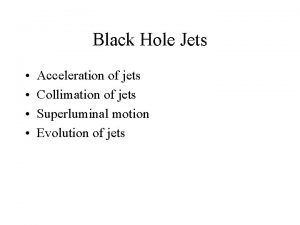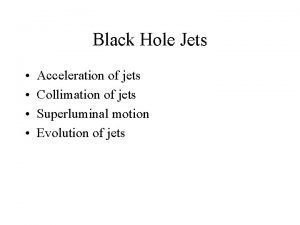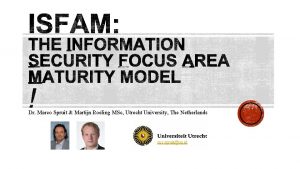Lecture III jets Marco van Leeuwen Utrecht University















































- Slides: 47

Lecture III: jets Marco van Leeuwen, Utrecht University Lectures for Helmholtz School Feb/March 2011

Generic expectations from energy loss Ejet k. T~m l fragmentation after energy loss? • Longitudinal modification: – out-of-cone energy lost, suppression of yield, di-jet energy imbalance – in-cone softening of fragmentation • Transverse modification – out-of-cone increase acoplanarity k. T – in-cone broadening of jet-profile 2

Medium modification of fragmentation MLLA calculation: good approximation for soft fragmentation extended with ad-hoc implementation medium modifications Borghini and Wiedemann, hep-ph/0506218 p. Thadron ~2 Ge. V for Ejet=100 Ge. V =ln(EJet/phadron) z 0. 37 0. 14 0. 05 0. 02 0. 007 Note small large z Suppression at high z, enhancement at low z 3

Fragmentation functions Qualitatively: Fragmentation functions sensitive to P(DE) Distinguish GLV from BDMPS? 4

Modified fragmentation functions Small-z enhancement from gluon fragments (only included in HT, not important for RAA) A. Majumder, Mv. L, ar. Xiv: 1002. 2206 Differences between formalisms large, both magnitude of supresion and z-dependence Can we measure this directly? Jet reconstruction 5

Jet shapes q-Pythia, Eur Phys J C 63, 679 Energy distribution in sub-jets Energy loss changes radial distribution of energy Several ‘new’ observables considered Discussion: sensitivity viability … ongoing 6

Fixing the parton energy with -jet events Input energy loss distribution T. Renk, PRC 74, 034906 Away-side spectra in -jet E = 15 Ge. V Nuclear modification factor Away-side spectra for -jet are sensitive to P(DE) -jet: know jet energy sensitive to P(DE) RAA insensitive to P(DE) 7

-jet in Au+Au Use shower shape in EMCal to form p 0 sample and -rich sample Combinatorial subtraction to obtain direct- sample 8

Direct- recoil suppression STAR, ar. Xiv: 0912. 1871 8 < ET, g < 16 Ge. V IAA(z. T) = DAA (z. T) Dpp (z. T) Large suppression for away-side: factor 3 -5 Reasonable agreement with model predictions NB: gamma p. T = jet p. T still not very large 9

Jet reconstruction algorithms Two categories of jet algorithms: • Sequential recombination k. T, anti-k. T, Durham – Define distance measure, e. g. dij = min(p. Ti, p. Tj)*Rij – Cluster closest • Cone – Draw Cone radius R around starting point – Iterate until stable h, jjet = <h, j>particles Sum particles inside jet Different prescriptions exist, most natural: E-scheme, sum 4 -vectors Jet is an object defined by jet algorithm If parameters are right, may approximate parton For a complete discussion, see: http: //www. lpthe. jussieu. fr/~salam/teaching/Ph. D-courses. html 10

Collinear and infrared safety Illustration by G. Salam Jets should not be sensitive to soft effects (hadronisation and E-loss) - Collinear safe - Infrared safe 11

Collinear safety Illustration by G. Salam Note also: detector effects, such as splitting clusters in calorimeter (p 0 decay) 12

Infrared safety Illustration by G. Salam Infrared safety also implies robustness against soft background in heavy ion collisions 13

Clustering algorithms – k. T algorithm 14

k. T algorithm Various distance measures have been used, e. g. Jade, Durham, Cambridge/Aachen Current standard choice: • Calculate – For every particle i: distance to beam – For every pair i, j : distance • Find minimal d – If di. B, i is a jet – If dij, combine i and j • Repeat until only jets 15

k. T algorithm demo 16

k. T algorithm properties • Everything ends up in jets • k. T-jets irregular shape – Measure area with ‘ghost particles’ • k. T-algo starts with soft stuff – ‘background’ clusters first, affects jet • Infrared and collinear safe • Naïve implementation slow (N 3). Not necessary Fastjet Alternative: anti-k. T Cambridge-Aachen: 17

Cone algorithm • Jets defined as cone • Iterate until stable: (h, j)Cone = <h, j>particles in cone • Starting points for cones, seeds, e. g. highest p. T particles • Split-merge prescription for overlapping cones 18

Cone algorithm demo 19

Seedless cone 1 D: slide cone over particles and search for stable cone Key observation: content of cone only changes when the cone boundary touches a particle Extension to 2 D (h, j) Limiting cases occur when two particles are on the edge of the cone 20

IR safety is subtle, but important G. Salam, ar. Xiv: 0906. 1833 21

Split-merge procedure • Overlapping cones unavoidable • Solution: split-merge procedure Evaluate Pt 1, Pt, shared – If Pt, shared/Pt 1> f f = 0. 5 … 0. 75 merge jets – Else split jets (e. g. assign Pt, shared to closest jet or split Pt, shared according to Pt 1/Pt 2) Jet 1 Jet 2 Merge: Pt, shared large fraction of Pt 1 Jet 2 Split: Pt, shared small fraction of Pt 1 22

Note on recombination schemes Simple Not boost-invariant for massive particles ET-weighted averaging: Most unambiguous scheme: E-scheme, add 4 -vectors Boost-invariant Needs particle masses (e. g. assign pion mass) Generates massive jets 23

Current best jet algorithms • Only three good choices: – k. T algorithm (sequential recombination, non-circular jets) – Anti-k. T algoritm (sequential recombination, circular jets) – SISCone algorithm (Infrared Safe Cone) + some minor variations: Durham algo, different combination schemes These are all available in the Fast. Jet package: http: //www. lpthe. jussieu. fr/~salam/fastjet/ Really no excuse to use anything else (and potentially run into trouble) 24

Speed matters G. Salam, ar. Xiv: 0906. 1833 At LHC, multiplicities are large A lot has been gained from improving implementations 25

Jet algorithm examples simulated p+p event Cacciari, Salam, Soyez, ar. Xiv: 0802. 1189 26

Di-jet kinematics Pout PTh 2 PL, h PT, jet 2 PTh 1 k. T, xy PT, jet 1 JT k. T measures di-jet acoplanarity JT distribution measures transverse jet profile PL, h distribution measures longitudinal jet profile Use z=p. L, h/Ejet or = ln(Ejet/p. L, h) approx indep of Ejet Di-hadron correlations: naïvely assume PTh 1~PTjet 1: z. T = p. T, h 2/p. Th 1 Pout ~ JT Not a good approximation! 27

Relating jets and single hadrons High-p. T hadrons from jet fragmentation Qualitatively: Inclusive hadrons are suppressed: - Suppression of jet yield (out-of-cone radiation) RAAjets < 1 - Modification of fragment distribution (in-cone radiation) softening of fragmentation function and/or broadening of jet structure 28

Jet reco p+p 200 Ge. V, p. Trec ~ 21 Ge. V STAR PHENIX p+p: no or little background Cu+Cu: some background 29

Jet finding in heavy ion events ~ 21 Ge. V Combinatorial background Needs to be subtracted pt per grid cell [Ge. V] Jets clearly visible in heavy ion events at RHIC STAR preliminary η j Use different algorithms to estimate systematic uncertainties: • Cone-type algorithms simple cone, iterative cone, infrared safe SISCone • Sequential recombination algorithms k. T, Cambridge, inverse k. T http: //rhig. physics. yale. edu/~putschke/Ahijf/A_Heavy_Ion_Jet-Finder. html Fast. Jet: Cacciari, Salam and Soyez; ar. Xiv: 0802. 1188 30

Jet finding with background By definition: all particles end up in a jet With background: all h-j space filled with jets Many of these jets are ‘background jets’ 31

Background estimate from jets Single event: p. T vs area r = p. T/area Background level Jet p. T grows with area Jet energy density r ~ independent of h M. Cacciari, ar. Xiv: 0706. 2728 32

Background energy density (Ge. V) Background subtraction STAR Preliminary multiplicity Background density at RHIC: 60 -100 Ge. V Strong dependence on centrality Fluctuations remain after subtraction: RMS up to 10 Ge. V 33

Example of dp. T distribution SIngle particle ‘jet’ p. T=20 Ge. V embedded in 8 M real events Response over ~5 orders of magnitude Gaussian fit to LHS: • LHS: good representation • RHS: non-Gaussian tail Response over range of ~40 Ge. V (sharply falling jet spectrum) • Centroid non-zero(~ ± 1 Ge. V) contribution to jet energy scale uncertainty 34

Unfolding background fluctuations Pythia smeared Pythia unfolded d. PT distribution: ‘smearing’ of jet spectrum due to background fluctuations unfolding Large effect on yields Need to unfold Simulation Test unfolding with simulation – works 35

Jet spectra p+p Au+Au central STAR Preliminary Note kinematic reach out to 50 Ge. V • Jet energy depends on R, affects spectra • k. T, anti-k. T give similar results Take ratios to compare p+p, Au+Au 36

Jet RAA at RHIC M. Ploskon, STAR, QM 09 Jet RAA >> 0. 2 (hadron RAA) Jet finding recovers most of the energy loss measure of initial parton energy Some dependence on jet-algorithm? Under study… 37

Jet R dependence p+p G. Soyez, ar. Xiv: 1101. 2665 R=0. 2/R=0. 4 ratio agrees with Pythia, Herwig Hadronisation effects important NLO QCD not enough 38

Jet R dependence Au+Au STAR, M. Ploskon, QM 09 RAA depends on jet radius: Small R jet is single hadron Jet broadening due to E-loss? 39

Fragmentation functions Use recoil jet to avoid biases pt, rec(Au. Au)>25 Ge. V STAR Preliminary E. Bruna, STAR, QM 09 20<pt, rec(Au. Au)<25 Ge. V Suppression of fragmentation also small (>> 0. 2) 40

Di-jet spectra Jet IAA STAR Preliminary E. Bruna, STAR, QM 09 Away-side jet yield suppressed partons absorbed . . . due to large path length (trigger bias) 41 41

Emerging picture from jet results • Jet RAA ~ 1 for sufficiently large R – unbiased parton selection • Away side jet fragmentation unmodified – away-side jet emerges without E-loss • Jet IAA ~ 0. 2 – Many jets are absorded (large E-loss) Study vs R, E to quantify P(DE) and broadening 42

Jet broadening II Qualitatively, two different possible scenarios Diffuse broadening Radiated energy ‘uniformly’ distributed Hard radiation/splitting Radiated energy directional Different measurements: - R(0. 2/0. 4) - Transverse jet profile May have different sensitivities Interesting idea: sub-jet structure; so far no studies available 43

Jet-hadron correlations J. Putschke STAR, INT workshop 0. 1 < p. T < 1. 0 Ge. V 1. 0 < p. T < 2. 5 Ge. V Jet anti-k. T, R=0. 4, p. Tcut = 2 Ge. V p. Trec = 20 (10) Ge. V p. T > 2. 5 Ge. V ‘Trigger’ jet: reconstruction bias (e. g. large charged fraction) Look at recoil jet Broadening at low p. T Suppression-enhancement (high-low p. T) 44

Jet-hadron correlations Yield Redistribution of fragments in longitudinal momentum Width Soft radiation at larger angle NB: no correction for trigger bias (jet energy), jet energy resolution (background fluctuations) 45

Extra slides 46

Unfolding background fluctuations Formally: Definition of dp. T Measured distribution Jet Signal In practice: Corrected Spectrum Response due to background fluctuations AS: Signal jet area AB: Background jet area AC: some suitably large cutoff area Measured distribution Regularized inverse 47
 Marco van leeuwen overleden
Marco van leeuwen overleden Bohr-van leeuwen theorem
Bohr-van leeuwen theorem Darmlavage definition
Darmlavage definition Marc van leeuwen
Marc van leeuwen Milou van leeuwen
Milou van leeuwen Negetar
Negetar Alice van leeuwen
Alice van leeuwen Frans van waarden utrecht
Frans van waarden utrecht Black hole jets
Black hole jets Microquasars
Microquasars Jets
Jets Jets
Jets Jets
Jets Beaming
Beaming Spice jets
Spice jets Spice jets
Spice jets Hamlet act iii scene ii
Hamlet act iii scene ii 01:640:244 lecture notes - lecture 15: plat, idah, farad
01:640:244 lecture notes - lecture 15: plat, idah, farad Marco conceptual y marco referencial
Marco conceptual y marco referencial Eduarte mbo amersfoort
Eduarte mbo amersfoort Utrecht fetatome
Utrecht fetatome Gza utrecht
Gza utrecht Ivlos utrecht
Ivlos utrecht Double house mvrdv
Double house mvrdv 3526 ks utrecht
3526 ks utrecht Webbouwer utrecht
Webbouwer utrecht Parapsychologie universiteit utrecht
Parapsychologie universiteit utrecht Vetmedlab
Vetmedlab Tratado de utrecht
Tratado de utrecht Bodemkaart utrecht
Bodemkaart utrecht Usbo utrecht
Usbo utrecht Calypso lean
Calypso lean Holy trinity church utrecht
Holy trinity church utrecht Holy trinity anglican church
Holy trinity anglican church De paraplu utrecht
De paraplu utrecht Anglican church utrecht
Anglican church utrecht Holy trinity church utrecht
Holy trinity church utrecht Rid utrecht
Rid utrecht Uu solis workspace
Uu solis workspace Traité d'utrecht
Traité d'utrecht Universiteit utrecht
Universiteit utrecht Welcome to utrecht
Welcome to utrecht Gevu 27
Gevu 27 Iras utrecht
Iras utrecht Usbo
Usbo Eric laenen
Eric laenen Oblique men utrecht
Oblique men utrecht Rvaring utrecht
Rvaring utrecht
